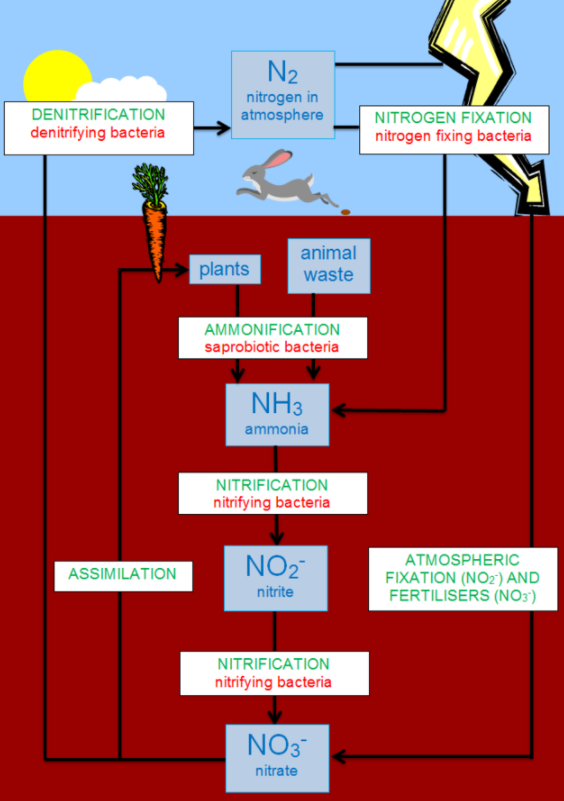
Draw nitrogen cycle? Explain the different steps.
Answer
501k+ views
1 likes
Hint: The nitrogen cycle is a multifaceted bio, geo, and chemical cycle in which the element nitrogen is renewed from its inactive distinctive molecular form
Complete answer:

The steps in the nitrogen cycle consist of:
> Nitrogen Fixation: It is defined as a process by which the molecular nitrogen in the atmosphere is transformed into the compound ammonia or associated nitrogenous complexes in soil. The atmospheric nitrogen is in the form of molecular dinitrogen, a moderately non-reactive molecule that is metabolic which is useless to all but helpful to a few microorganisms.
> Ammonification: The process of Ammonification normally refers to any chemical reaction wherein the groups of
> Nitrification: It is a process in which ammonium ions are transformed into nitrates.
The element nitrogen up taking by plants:
The nitrate which is formed in the process of Nitrification is used by most florae as inorganic metabolites and can be changed by them into amino collections and other nitrogen-comprising mixtures.
> The fixation of Nitrogen: The process of reduction of distinctive nitrogen to the ammonium ion
> The Denitrification: The process of reduction of remaining nitrates to nitrogen gas or nitrous oxide by certain microorganisms.
Note: It is significant to note that the various types of microorganisms play an imperative role in each of the following steps. Nitrous oxide
Complete answer:

The steps in the nitrogen cycle consist of:
> Nitrogen Fixation: It is defined as a process by which the molecular nitrogen in the atmosphere is transformed into the compound ammonia or associated nitrogenous complexes in soil. The atmospheric nitrogen is in the form of molecular dinitrogen, a moderately non-reactive molecule that is metabolic which is useless to all but helpful to a few microorganisms.
> Ammonification: The process of Ammonification normally refers to any chemical reaction wherein the groups of
> Nitrification: It is a process in which ammonium ions are transformed into nitrates.
The element nitrogen up taking by plants:
The nitrate which is formed in the process of Nitrification is used by most florae as inorganic metabolites and can be changed by them into amino collections and other nitrogen-comprising mixtures.
> The fixation of Nitrogen: The process of reduction of distinctive nitrogen to the ammonium ion
> The Denitrification: The process of reduction of remaining nitrates to nitrogen gas or nitrous oxide by certain microorganisms.
Note: It is significant to note that the various types of microorganisms play an imperative role in each of the following steps. Nitrous oxide
Latest Vedantu courses for you
Grade 10 | MAHARASHTRABOARD | SCHOOL | English
Vedantu 10 Maharashtra Pro Lite (2025-26)
School Full course for MAHARASHTRABOARD students
₹33,300 per year
Recently Updated Pages
Master Class 11 Economics: Engaging Questions & Answers for Success

Master Class 11 Business Studies: Engaging Questions & Answers for Success

Master Class 11 Accountancy: Engaging Questions & Answers for Success

Master Class 11 English: Engaging Questions & Answers for Success

Master Class 11 Computer Science: Engaging Questions & Answers for Success

Master Class 11 Maths: Engaging Questions & Answers for Success

Trending doubts
State and prove Bernoullis theorem class 11 physics CBSE

1 ton equals to A 100 kg B 1000 kg C 10 kg D 10000 class 11 physics CBSE

State the laws of reflection of light

One Metric ton is equal to kg A 10000 B 1000 C 100 class 11 physics CBSE

1 Quintal is equal to a 110 kg b 10 kg c 100kg d 1000 class 11 physics CBSE

Difference Between Prokaryotic Cells and Eukaryotic Cells




